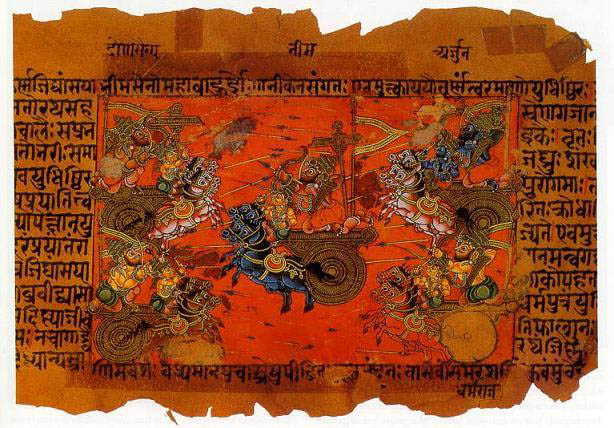

The Mahabharata is the longest, and one of the two major Sanskrit epics of ancient India, the other being the Ramayana. Besides its epic narrative of the Kurukshetra War and the fates of the Kauravas and the Pandava princes, the Mahabharata contains much philosophical and devotional material, such as a discussion of the four "goals of life" or purusharthas (12.161). The latter are enumerated as dharma (right action), artha (purpose), kama (pleasure), and moksha (liberation). Among the principal works and stories that are a part of the Mahabharata are the Bhagavad Gita, the story of Damayanti, an abbreviated version of the Ramayana, and the Rishyasringa, often considered as works in their own right.
Its longest version consists of over 100,000 shloka or over 200,000 individual verse lines (each shloka is a couplet), and long prose passages. About 1.8 million words in total, the Mahabharata is roughly ten times the length of the Iliad and Odyssey combined, or about four times the length of the Ramayana. W. J. Johnson has compared the importance of the Mahabharata to world civilization to that of the Bible, the works of Shakespeare, the works of Homer, Greek drama, or the Qur'an.
The Mahabharata is a mythological tale that combines facts and fancy - legends and soap operas - replete with metaphoric content which can easily be interpreted in today's world where the reality and truth are seeping into present day consciousness.
The images below reflect the same iconology found in all other ancient civilizations in the physical journey of humanity on planet Earth in this and other timelines. The myths and metaphors are all here if you can understand them.
Chariots of fire representing UFOs of one kind or another
Spoked wheels - wheels within wheels - gears of time and synchronicity - wheel of time or alchemy.
Snakes or human DNA in a biogenetic experiment set in physical space and linear time
Gods mating with human women to create the human race in their image
Blue star gods - blue bloods or royal bloodlines descended directly from the gods
The mythical battles of Heaven and Earth - Physical Reality vs. Higher Frequency - Duality
Mythical wars between the gods witnessed and depicted by humans since the beginning of time
Krishna in blue riding in a chariot
The snake sacrifice of Janamejaya
Depiction at Angkor Wat of Vyasa narrating
Traditionally, the authorship of the Mahabharata is attributed to Vyasa. There have been many attempts to unravel its historical growth and compositional layers. The oldest preserved parts of the text are not thought to be appreciably older than around 400 BCE, though the origins of the story probably fall between the 8th and 9th centuries BCE. The text probably reached its final form by the early Gupta period (ca. fourth century CE). The title may be translated as "the great tale of the Bharata dynasty". According to the Mahabharata itself, the tale is extended from a shorter version of 24,000 verses called simply Bharata.
Ganesha writing the Mahabharata
A scene from the Mahabharata war, Angkor Wat - A black stone relief depicting a number of men wearing a crown and a dhoti, fighting with spears, swords and bows. A chariot with half the horse out of the frame - is seen in the middle. Note the spoked wheel ....
Krishna as portrayed in Yakshagana from Karnataka
The struggle culminates in the great battle of Kurukshetra, in which the Pandavas are ultimately victorious. The battle produces complex conflicts of kinship and friendship, instances of family loyalty and duty taking precedence over what is right, as well as the converse.
The Mahabharata itself ends with the death of Krishna, and the subsequent end of his dynasty and ascent of the Pandava brothers to heaven. It also marks the beginning of the Hindu age of Kali (Kali Yuga - see 2012 reference), the fourth and final age of mankind, in which great values and noble ideas have crumbled, and man is heading toward the complete dissolution of right action, morality and virtue.
Arshia Sattar states that the central theme of the Mahabharata, as well as the Ramayana, is respectively Krishna's and Rama's hidden divinity and its progressive revelation.
Shantanu woos Satyavati, the fisherwoman
As the myth (story) goes ...
Shantanu, the king of Hastinapura, has a short-lived marriage with the goddess Ganga and has a son, Devavrata (later to be called Bhishma, a great warrior), who becomes the heir apparent. Many years later, when King Shantanu goes hunting, he sees Satyavati, the daughter of the chief of fisherman, and asks her father for her hand. Her father refuses to consent to the marriage unless Shantanu promises to make any future son of Satyavati the king upon his death. To resolve his father's dilemma, Devavrata agrees to relinquish his right to the throne. As the fisherman is not sure about the prince's children honouring the promise, Devavrata also takes a vow of lifelong celibacy to guarantee his father's promise.
Shantanu has two sons by Satyavati, Chitrangada and Vichitravirya. Upon Shantanu's death, Chitrangada becomes king. He lives a very short uneventful life and dies. Vichitravirya, the younger son, rules Hastinapura. Meanwhile, the King of Kasi arranges a swayamvara for his three daughters, neglecting to invite the royal family of Hastinapur. In order to arrange the marriage of young Vichitravirya, Bhishma attends the swayamvara of the three princesses Amba, Ambika and Ambalika, uninvited, and proceeds to abduct them. Ambika and Ambalika consent to be married to Vichitravirya.
The oldest princess Amba, however, informs Bhishma that she wishes to marry king of Shalva whom Bhishma defeated at their swayamvara. Bhishma lets her leave to marry king of Shalva, but Shalva refuses to marry her, still smarting at his humiliation at the hands of Bhishma. Amba then returns to marry Bhishma but he refuses due to his vow of celibacy. Amba becomes enraged and becomes Bhishma's bitter enemy, holding him responsible for her plight. Later she is reborn to King Drupada as Shikhandi (or Shikhandini) and causes Bhishma's fall, with the help of Arjuna, in the battle of Kurukshetra.
When Vichitravirya dies young without any heirs, Satyavati asks her first son Vyasa to father children with the widows. The eldest, Ambika, shuts her eyes when she sees him, and so her son Dhritarashtra is born blind. Ambalika turns pale and bloodless upon seeing him, and thus her son Pandu is born pale and unhealthy (the term Pandu may also mean 'jaundiced'). Due to the physical challenges of the first two children, Satyavati asks Vyasa to try once again. However, Ambika and Ambalika send their maid instead, to Vyasa's room. Vyasa fathers a third son, Vidura, by the maid. He is born healthy and grows up to be one of the wisest characters in the Mahabharata. He serves as Prime Minister (Mahamantri or Mahatma) to King Pandu and King Dhritarashtra.
When the princes grow up, Dhritarashtra is about to be crowned king by Bhishma when Vidura intervenes and uses his knowledge of politics to assert that a blind person cannot be king. This is because a blind man cannot control and protect his subjects. The throne is then given to Pandu because of Dhritarashtra's blindness. Pandu marries twice, to Kunti and Madri.
Dhritarashtra marries Gandhari, a princess from Gandhara, who blindfolds herself so that she may feel the pain that her husband feels. Her brother Shakuni is enraged by this and vows to take revenge on the Kuru family. One day, when Pandu is relaxing in the forest, he hears the sound of a wild animal. He shoots an arrow in the direction of the sound. However the arrow hits the sage Kindama, who curses him that if he engages in a sexual act, he will die. Pandu then retires to the forest along with his two wives, and his brother Dhritarashtra rules thereafter, despite his blindness.
Pandu's older queen Kunti, however, had been given a boon by Sage Durvasa that she could invoke any god using a special mantra. Kunti uses this boon to ask Dharma the god of justice, Vayu the god of the wind, and Indra the lord of the heavens for sons. She gives birth to three sons, Yudhisthira, Bhima, and Arjuna, through these gods. Kunti shares her mantra with the younger queen Madri, who bears the twins Nakula and Sahadeva through the Ashwini twins. However, Pandu and Madri indulge in sex, and Pandu dies. Madri dies on his funeral pyre out of remorse. Kunti raises the five brothers, who are from then on usually referred to as the Pandava brothers.
Dhritarashtra has a hundred sons through Gandhari, all born after the birth of Yudhishtira. These are the Kaurava brothers, the eldest being Duryodhana, and the second Dushasana. Other Kaurava brothers were Vikarna and Sukarna. The rivalry and enmity between them and the Pandava brothers, from their youth and into manhood, leads to the Kurukshetra war. Read more ...
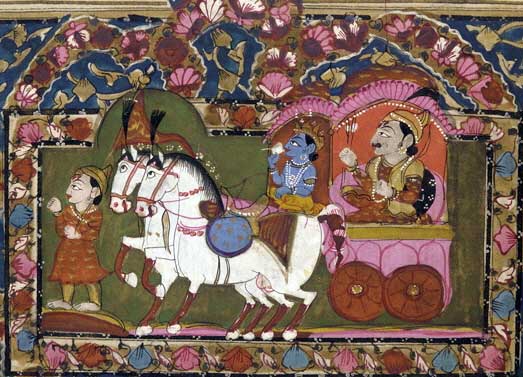
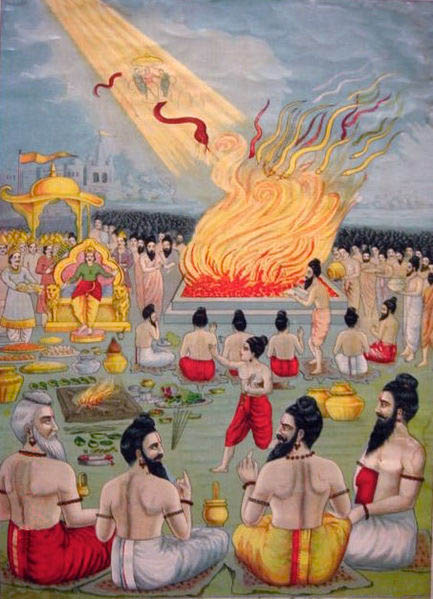
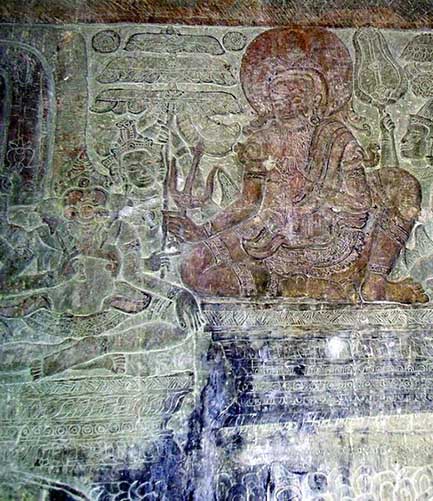
the Mahabharata to Ganesha, his scribe.
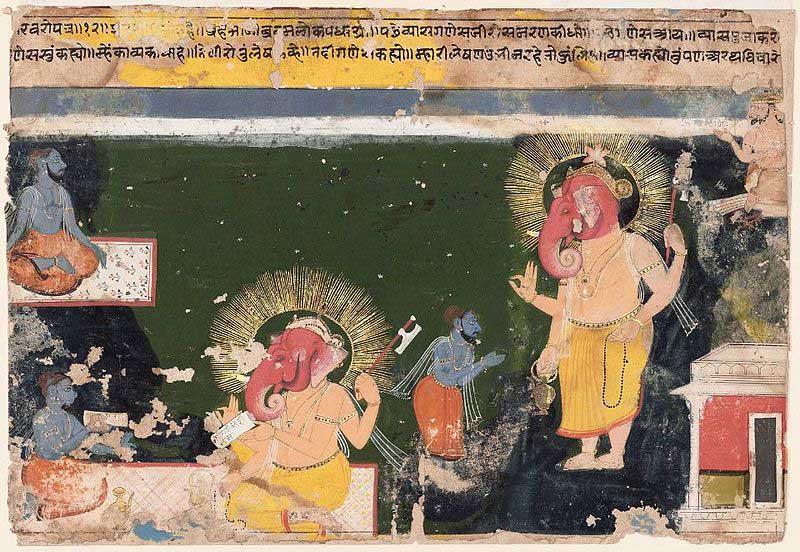
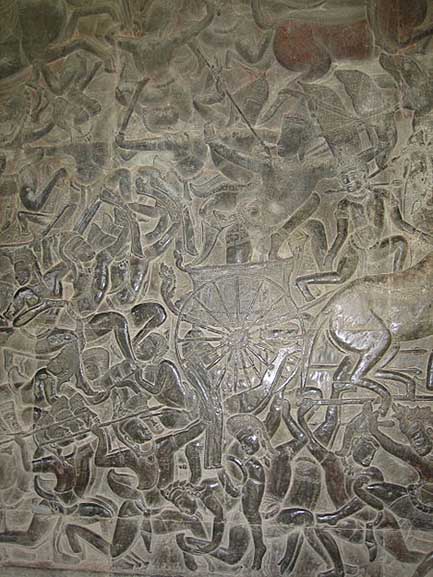
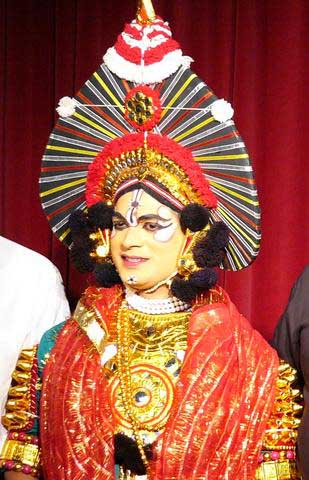
which is based largely on stories of Mahabharata
The core story of the Mahabharata is that of a dynastic struggle for the throne of Hastinapura, the kingdom ruled by the Kuru clan. The two collateral branches of the family that participate in the struggle are the Kaurava and the Pandava. Although the Kaurava is the senior branch of the family, Duryodhana, the eldest Kaurava, is younger than Yudhisthira, the eldest Pandava. Both Duryodhana and Yudhisthira claim to be first in line to inherit the throne.
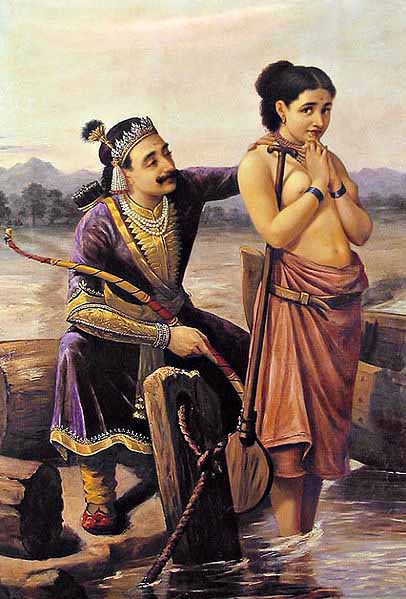
Painting by Raja Ravi Varma